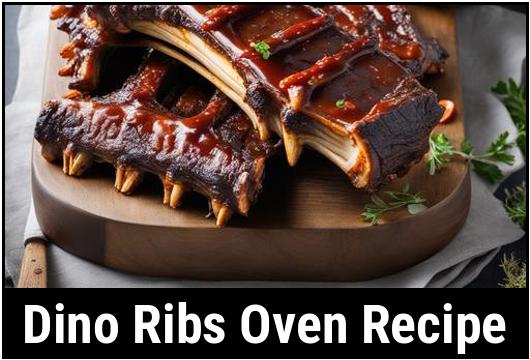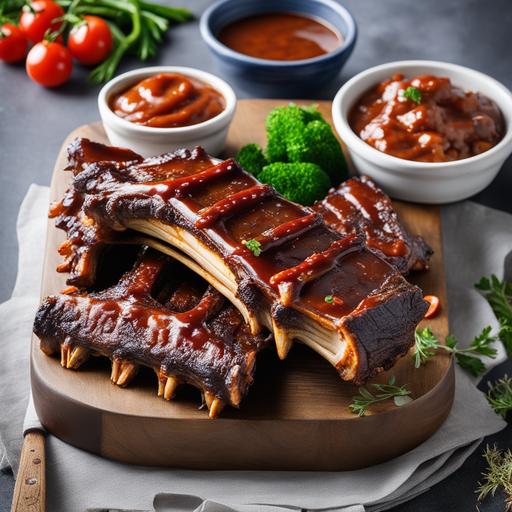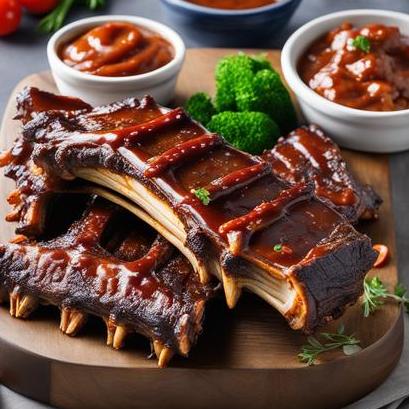
Dino Ribs Oven Recipe: A Culinary Delight For Meat Lovers
Introduction
If you consider yourself a true carnivore and have an insatiable appetite for succulent, tender, and flavorful meat, then look no further than dino ribs. These massive slabs of meat, reminiscent of prehistoric times, are guaranteed to satisfy even the most discerning palate. In this comprehensive article, we will delve into the fascinating world of dino ribs, exploring the scientific, culinary, and practical aspects of this culinary masterpiece. Get ready to embark on a gastronomic adventure to prepare the perfect dino ribs recipe!
The Science of Meat: Understanding Dino Ribs
Before diving into the details of preparing dino ribs, it’s essential to understand the science behind this prized cut of meat. Dino ribs, or beef ribs, are taken from the beef chuck primal, specifically the plate and short rib sections. These ribs are known for their rich marbling, which lends incredible flavor and tenderness to the meat. The bone-in nature of dino ribs ensures even heat distribution during the cooking process, resulting in succulent and juicy meat with a mouth-watering texture.
Selecting the Perfect Dino Ribs
When selecting dino ribs, the quality of the meat is of utmost importance. Look for ribs that are well-marbled, with a nice balance of fat and lean meat. This marbling not only enhances the taste but also adds moisture during cooking, preventing the ribs from becoming dry and tough.
Furthermore, you should ensure the ribs are fresh, with no unpleasant odor or discoloration. Opt for ribs that have been properly trimmed, with excess fat removed, as this will prevent any unpleasant greasiness in the final dish.
Cleaning and Preparation: The Initial Steps to Culinary Excellence

Before diving into the culinary journey of preparing dino ribs, it’s crucial to clean and prepare the meat properly. Start by rinsing the ribs under cool water to remove any loose bone fragments or debris. Pat them dry using a paper towel, ensuring you remove excess moisture that can hinder the formation of a delicious crust during cooking.
Once the ribs are dry, it’s time to season them. The choice of seasonings largely depends on personal preference. A classic combination of salt, black pepper, and garlic powder makes an excellent foundation for a dino rib rub. However, feel free to experiment by adding your favorite herbs and spices, such as paprika, cayenne pepper, or even oregano. Remember, the goal is to enhance the natural flavors of the meat without overpowering them.
Tips for Mastering Dino Ribs
To achieve a truly exceptional dino ribs dish, it’s essential to follow a few key tips:
1. Prep the Meat in Advance: For maximum flavor, season your dino ribs and refrigerate them for at least two hours, allowing the flavors to penetrate the meat.
2. Bring the Ribs to Room Temperature: Before placing them in the oven, let the ribs sit at room temperature for around 30 minutes. This step ensures even cooking throughout.
3. Low and Slow: The Preferred Cooking Method: Dino ribs are best cooked using the low and slow method, which involves slow-cooking them at a low temperature for an extended period. This technique allows the collagen in the meat to break down gradually, resulting in tender and melt-in-your-mouth ribs.
The Perfect Doneness: Checking for Carnivorous Perfection
Determining the ideal doneness of dino ribs can be a bit tricky, but fear not! There are several reliable methods to ensure your mouth-watering dino ribs are cooked to perfection:
1. Visual Indicators: One way to gauge doneness is by examining the color of the meat. Ideally, you’re looking for a beautiful caramelized crust on the outside, with a pinkish interior. The pink color indicates that the meat is cooked to medium-rare perfection. If you prefer your meat more well-done, continue cooking until it reaches your desired level of doneness.
2. Probe Test: Another foolproof method is to use an instant-read meat thermometer. Insert the probe into the thickest part of the meat, being careful not to touch the bone. For medium-rare ribs, aim for an internal temperature of around 145°F (63°C), whereas medium doneness ranges from 155°F to 160°F (68°C to 71°C).
The Infallible Dino Ribs Oven Recipe

Now that you understand the intricacies of dino ribs, it’s time to unveil a delectable recipe that will undoubtedly elevate your culinary repertoire. Brace yourself for an explosion of flavor and unmatched tenderness with this tried-and-true dino ribs oven recipe:
Ingredients:
-
4 pounds (1.8 kg) beef dino ribs
-
2 tablespoons kosher salt
-
1 tablespoon black pepper
-
1 tablespoon garlic powder
-
1 tablespoon paprika
-
1 teaspoon cayenne pepper (optional, for a spicy kick)
Instructions:
-
Preheat your oven to 275°F (135°C).
-
In a small bowl, combine salt, black pepper, garlic powder, paprika, and cayenne pepper (if using).
-
Pat the dino ribs dry with a paper towel and generously season both sides of the ribs with the seasoning mixture.
-
Place the ribs, bone side down, on a wire rack set inside a baking dish. This helps elevate the ribs, allowing for even heat distribution and proper air circulation.
-
Cover the baking dish tightly with aluminum foil, ensuring no steam can escape.
-
Transfer the dish to the preheated oven and let the dino ribs cook undisturbed for approximately 4-5 hours. Slow and steady cooking will yield the best results.
-
After the initial cooking time, remove the foil and increase the oven temperature to 400°F (200°C).
-
Return the ribs to the oven for an additional 20-30 minutes, or until a desirable crust forms on the outside.
-
Once the desired doneness is achieved, remove the ribs from the oven and let them rest for 10-15 minutes. This resting period allows the juices to redistribute and ensures maximum flavor in every bite.
-
Slice the ribs between the bones, and serve them with your favorite barbecue sauce or enjoy them as they are. Either way, prepare to be transported to carnivorous bliss!
Variety is the Spice of Life: Dino Rib Recipe Variations
While the classic oven-roasted dino ribs recipe is guaranteed to impress, there are countless variations that allow you to explore diverse flavor profiles and culinary techniques. Here are a few tantalizing options to consider:
1. Smoky and Sweet: Enhance the flavor of your dino ribs by adding a smoky twist. Prepare a dry rub using brown sugar, smoked paprika, cumin, and a touch of cinnamon. The resulting combination of sweet and smoky flavors will leave your taste buds dancing.
2. Asian-inspired Fusion: Infuse your dino ribs with a spicy and aromatic Asian twist. Create a marinade using soy sauce, garlic, ginger, Sriracha, and a splash of sesame oil. Let the ribs marinate for a few hours before baking, ensuring they absorb all the savory Asian flavors.
3. Bourbon-Glazed Delight: Elevate your dino ribs to the next level with a tangy bourbon glaze. Whip up a mixture of bourbon, brown sugar, Worcestershire sauce, and Dijon mustard. Brush the glaze onto the ribs during the last 30 minutes of cooking for a sticky and irresistible finish.
Overcooking and Undercooking: Time is of the Essence
While cooking dino ribs to perfection is the goal, occasionally, things don’t go as planned. Overcooking or undercooking can happen to even the most seasoned chefs. Here’s how to fix these common mishaps:
1. Overcooked Ribs: If you realize your ribs are overcooked, don’t panic. You can salvage them by wrapping them in foil with a small amount of liquid, such as beef broth or apple juice. Place the foil-wrapped ribs in a warm oven for about 30 minutes to help rehydrate and tenderize the meat.
2. Undercooked Ribs: In the unfortunate event of undercooked ribs, you can resolve this by returning them to the oven and continuing to cook at a low temperature until they reach your desired level of doneness. Keep a close eye on them to prevent overcooking.
Conclusion: Indulge in the Unforgettable Dino Ribs Experience
Preparing dino ribs is not just a cooking endeavor; it’s an immersive culinary experience that will leave you and your guests in awe. From selecting the perfect cut of meat to mastering the art of cooking, this comprehensive article has provided you with all the knowledge and inspiration needed to embark on your dino ribs adventure. Embrace the flavors, unleash your creativity, and enjoy the mouth-watering meat that still echoes the prehistoric era. Delight in the carnivorous delight that is dino ribs, and let your taste buds savor every succulent bite!
Sources
FAQS On Dino Ribs Oven Recipe
What Ingredients Do I Need For A Dino Ribs Oven Recipe?
For a dino ribs oven recipe, you will need pork spare ribs, brown sugar, smoked paprika, garlic powder, onion powder, salt, black pepper, barbecue sauce, and foil.
How Do I Prepare The Dino Ribs Oven Recipe?
Preheat your oven to 275°F. Mix the brown sugar, smoked paprika, garlic powder, onion powder, salt, and black pepper together in a bowl. Rub the mixture onto the pork spare ribs. Place the ribs onto a large sheet of foil and wrap them tightly. Bake the ribs in the oven for 3 hours.
How Do I Know If The Dino Ribs Are Done?
Test the tenderness of the ribs by inserting a toothpick into the thickest part of the meat. The toothpick should easily slide in and out of the meat. Another way to test whether the ribs are done is to lift up one end of the foil to see whether the meat is falling off the bones.
What Is The Best Way To Serve The Dino Ribs?
After the ribs have been cooked for three hours in the oven, open the foil. Brush a generous amount of barbecue sauce onto the ribs and bake them, uncovered, for another 30 minutes. The ribs can be served with additional barbecue sauce on the side.
Can I Use A Different Type Of Meat Besides Pork For The Dino Ribs Oven Recipe?
Yes, you can use beef or lamb spare ribs instead of pork spare ribs. Adjust the cooking time according to the thickness and weight of the meat, and ensure the meat is well-coated with the spice rub before cooking.



